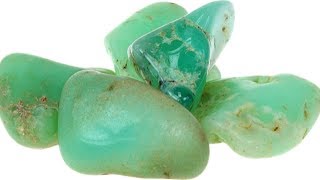Chrysoprase a Green Chalcedony
Chrysoprase a Green Chalcedony

What is Chrysoprase?
Chrysoprase is the name of a translucent chalcedony that ranges in color between yellowish green and green. Its green color is usually caused by traces of nickel.
Beautiful green chrysoprase is the second most valuable variety of chalcedony after gem silica. The name “chrysoprase” is from the Greek words for “golden apple” or “golden leek.”
Today it is most often used for making beads and cabochons. Exceptional pieces of chrysoprase are sometimes cut into translucent faceted stones.
Chrysoprase as a gemstone was known to the ancient Greeks and Romans. A few pieces have been found among their artifacts, but its use in that time was not common. Chrysoprase first became a popular gem in Europe after deposits in Poland were discovered in the 1700s. Today, most chrysoprase is produced in Australia, but it is not widely used because supplies are limited.
Color in Chrysoprase
The color of chrysoprase is mainly determined by its nickel content; however, the nickel can occur within the microcrystalline quartz in multiple ways. Small amounts of nickel silicate admixed with the quartz, dispersed nickel oxide, and free nickel ions might all contribute to the green color of chrysoprase.
The nickel is not believed to enter the lattice of the microcrystalline quartz. Chrysoprase occurs in a range of green colors. These range from a pale yellowish green to a deeply saturated green.
The abundance of nickel determines the strength of the green color. Pale yellowish green specimens can contain between 0.2 and 1.0 weight percent nickel oxide.
Deep green specimens can contain up to 5 weight percent nickel oxide.
The color in some specimens of chrysoprase is unstable. Prolonged exposure to sunlight can cause it to fade.
If faded specimens are found at the surface in the field, better color might be found just below the surface. Heat can also cause color fading in chrysoprase. Care should be taken during jewelry repair to avoid heating the stone.
Cut stones and gem materials should not be stored or displayed where they will be exposed to direct sunlight or heat. A box, drawer, or jewelry cabinet, stored away from heat sources, can provide protection.
Geology and Distribution of Chrysoprase
Chrysoprase deposits occur at shallow depths in areas where nickel-bearing rocks have been weathered. There it is found as cavity, vein, and fracture fillings.
Veins and fractures are usually under a few inches in width and rarely exceed several feet in length. Chrysoprase is mined by the kilogram and not by the ton.
Chrysoprase is usually found within or associated withperidotite, dunite, and serpentinite. These rocks are often part of an ophiolite or a subduction zone. The nickel that produces the green color of chrysoprase is liberated as these rocks are weathered.
Much of the world’s early chrysoprase was produced from surface and underground workings at the Szklary deposit in Poland. Mining began there in the Middle Ages and continued intermittently until 1980, with renewed activity at the site starting in 2010.
Australia is the leading producer of chrysoprase today. Much of the best chrysoprase is mined in the Marlborough Creek District of Queensland, Australia.
Many other deposits are worked in New South Wales, South Australia, and Western Australia. Chrysoprase is also found in other parts of the world. These include Kazakhstan, the Czech Republic, Brazil, Tanzania, India, Slovakia, Russia, and California.
Facebook
Twitter
Google+
Please Like And Subscribe Sky News
Disclaimer:
pictures, or videos on this channel sometimes from various other sources, copyright is fully held by the sources. If there are problem related to this, You can contact us in this email
Email : vinawatiakun@gmail.com
COPYRIGHT DISCLAIMER
“Copyright Disclaimer Under Section 107 of the Copyright Act? 1976, allowance is made for “fair use” for purposes such as criticism, comment, news reporting, teaching, scholarship, and research. Fair use is a use permitted by copyright statute that might otherwise be infringing. Non-profit, educational or personal use tips the balance in favor of fair use.”
